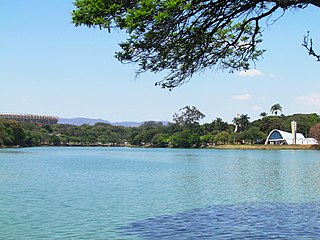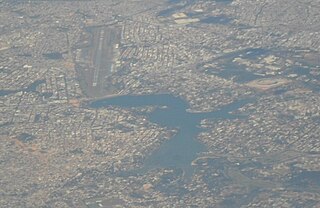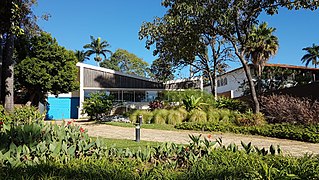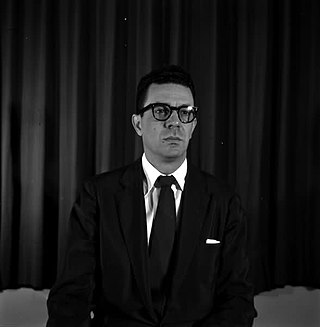
Oscar Ribeiro de Almeida Niemeyer Soares Filho, known as Oscar Niemeyer, was a Brazilian architect considered to be one of the key figures in the development of modern architecture. Niemeyer was best known for his design of civic buildings for Brasília, a planned city that became Brazil's capital in 1960, as well as his collaboration with other architects on the headquarters of the United Nations in New York. His exploration of the aesthetic possibilities of reinforced concrete was highly influential in the late 20th and early 21st centuries.

Belo Horizonte is the sixth-largest city in Brazil, with a population of around 2.7 million, and the third largest metropolitan area, with a population of 6 million. It is the 13th-largest city in South America and the 18th-largest in the Americas. The metropolis is anchor to the Belo Horizonte metropolitan area, ranked as the third most populous metropolitan area in Brazil and the 17th most populous in the Americas. Belo Horizonte is the capital of the state of Minas Gerais, Brazil's second-most populous state. It is the first planned modern city in Brazil.

The Guignard University of Art of Minas Gerais is a university of fine arts in Belo Horizonte, Minas Gerais, Brasil. It was founded on 28 February 1944 by the Brazilian painter Alberto da Veiga Guignard (1896-1962) on request of Juscelino Kubitschek, mayor of Belo Horizonte and later President of Brazil. Guignard became a noted arts educator in Brazil and remained a professor at Guignard for the remainder of his life.

Lake Pampulha is an artificial lake located in Pampulha, Belo Horizonte, Brazil. It is also the name of an administrative region of Belo Horizonte, and the name of one of 29 neighborhoods (bairros) within the administrative region of the same name. The lake was built in the early 1940s during the mayoralty of Juscelino Kubitschek, later president of Brazil from 1956 to 1961. Pampulha was created as a source of water for the city of Belo Horizonte, but quickly became polluted.

The Gustavo Capanema Palace, also known architecturally as the Ministry of Education and Health Building, is a government office building in the Centro district of Rio de Janeiro, Brazil. As the first modernist project in Brazil, it is historically important to the architectural development of Modernism in Brazil and has been placed on Brazil's UNESCO tentative list.

The Church of Saint Francis of Assisi is a chapel in Pampulha region of Belo Horizonte, in the state of Minas Gerais, southeastern Brazil. It was designed by the Brazilian architect Oscar Niemeyer in the organic modern style. It is the first listed modern architectural monument in Brazil and consists of four undulating concrete parabolas with outdoor mosaics. The interior hosts a mural by Candido Portinari, and the exterior features a landscape designed by Roberto Burle Marx.
NAB – Navegação Aérea Brasileira was a Brazilian airline founded in 1938. In 1961 it was sold to Lóide Aéreo Nacional.

Pampulha is an administrative region in the city of Belo Horizonte, Brazil. It is one of nine administrative regions of Belo Horizonte, and occupies 47.13 kilometres (29.29 mi) in the northeast of the city. It has a population of 145,262 and a population density of 3.08 per square kilometer. The center of the Pampulha is occupied by Lake Pampulha, an artificial lake constructed in the early 1940s by Mayor Juscelino Kubitschek, later president of Brazil from 1956 to 1961. The Pampulha administrative region is further subdivided into 29 neighborhoods (bairros), one of which is also called Pampulha.

The Pampulha Modern Ensemble is an urban project in Belo Horizonte, Minas Gerais, Brazil. It was designed around an artificial lake, Lake Pampulha, in the district of Pampulha and includes a casino, a ballroom, the Golf Yacht Club and the Church of Saint Francis of Assisi. The buildings were designed by the architect Oscar Niemeyer, in collaboration with the landscape architect Roberto Burle Marx, Brazilian Modernist artists, and engineer Joaquim Cardozo.

The Pedregulho Housing Complex is an apartment complex and planned community in the Benfica neighborhood of Rio de Janeiro, Brazil. It was designed by the architect Affonso Eduardo Reidy (1909-1964). The project was planned in 1946 to house lower-paid civil servants of the city, which was then the Federal District of Brazil. Work commenced on the complex in 1949 and inaugurated in 1951/1952.

The architecture of Brazil is influenced by Europe, especially Portugal. It has a history that goes back 500 years to the time when Pedro Cabral discovered Brazil in 1500. Portuguese colonial architecture was the first wave of architecture to go to Brazil.

The Kubitschek Residence Museum is a museum house located on the shore of Lake Pampulha in Belo Horizonte, Minas Gerais, Brazil. The building served as the weekend residence of Juscelino Kubitschek, prefect of Belo Horizonte at the time.

Paul Clemence is an American-Brazilian photo-artist, focused on registering the expressive side of the built environment, particularly architecture. Beyond exhibiting his artwork, he lectures frequently and has authored several books.

Sylvio Carvalho de Vasconcellos was a Brazilian architect and architectural historian, also recognized as one of the pioneers of Brazilian modernist architecture in the state of Minas Gerais.

The Iate Tênis Clube is a recreational club located on the shore of the Lake Pampulha in Belo Horizonte. Its building was designed by architect Oscar Niemeyer in the early 1940s, integrating the Pampulha Architectural Complex, recognized by UNESCO as a World Heritage Site since 2016.

The Pampulha Art Museum, formerly known as Cassino da Pampulha, is a building that is part of the Pampulha Modern Ensemble located in Belo Horizonte, Minas Gerais, Brazil. The building was designed by the architect Oscar Niemeyer at the request of the then-mayor of the city, Juscelino Kubitschek, and is recognized by UNESCO as a World Heritage Site along with the rest of the ensemble since 2016.

Maria Josefina de Vasconcellos, often referred to as Jô Vasconcellos, is a Brazilian architect, urban planner, and landscape designer. She has designed several important buildings and complexes in the city of Belo Horizonte, including the Centro de Cultura Presidente Itamar Franco and the Rainha da Sucata Building

The Niemeyer Building is a residential building located in Belo Horizonte, Brazil, designed by the architect Oscar Niemeyer and constructed between 1954 and 1960. It is an iconic piece of Brazilian modernistic architecture.
Fernando Maculan Assumpção is a Brazilian architect, urban planner and industrial designer. He has received different awards for architecture and design projects, including the Antwerp Diamond High Council Award in 2003 for jewelry design, the national prizes from the Institute of Architects of Brazil and the Tomie Ohtake Institute AkzoNobel for the Lá da Favelinha Cultural Center project in 2021, and the ArchDaily world House of the Year award in 2023.























